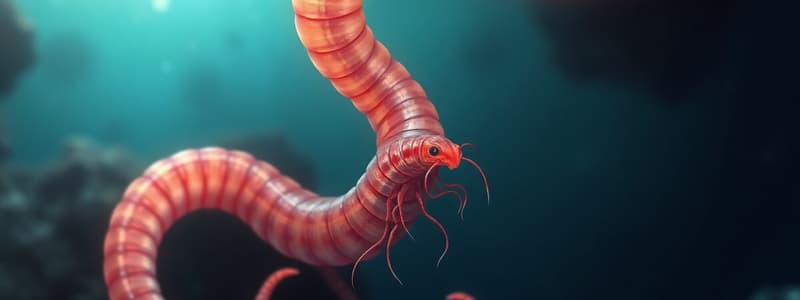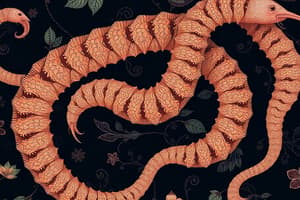Podcast
Questions and Answers
What is the primary function of the coelom in annelids?
What is the primary function of the coelom in annelids?
- Storing digested food
- Acting as a hydrostatic skeleton (correct)
- Facilitating gas exchange
- Filtering waste products
All annelids possess specialized gas exchange structures like gills or lungs.
All annelids possess specialized gas exchange structures like gills or lungs.
False (B)
What is the role of the gizzard in the annelid digestive system?
What is the role of the gizzard in the annelid digestive system?
grinding food
In annelids, oxygen is carried by the respiratory pigment ________, which is dissolved in the fluid portion of the blood.
In annelids, oxygen is carried by the respiratory pigment ________, which is dissolved in the fluid portion of the blood.
Match the following structures in annelids with their respective functions:
Match the following structures in annelids with their respective functions:
What is the function of the aortic arches in annelids?
What is the function of the aortic arches in annelids?
Annelids can only reproduce sexually.
Annelids can only reproduce sexually.
What is the primary role of earthworms in soil ecosystems?
What is the primary role of earthworms in soil ecosystems?
The internal opening of the metanephridium is surrounded by ________, which beat and draw fluid into the tube.
The internal opening of the metanephridium is surrounded by ________, which beat and draw fluid into the tube.
What describes the digestive system of annelids?
What describes the digestive system of annelids?
The blood in all types of marine annelids is iron-based, giving it a red color.
The blood in all types of marine annelids is iron-based, giving it a red color.
What is the name given to freshwater "earthworms" that contain large amounts of hemoglobin and are sold as fish food?
What is the name given to freshwater "earthworms" that contain large amounts of hemoglobin and are sold as fish food?
During sexual reproduction in annelids, a structure called the ________ secretes a cocoon of mucus that picks up eggs and sperm.
During sexual reproduction in annelids, a structure called the ________ secretes a cocoon of mucus that picks up eggs and sperm.
Which of the following best describes the circulatory system of earthworms?
Which of the following best describes the circulatory system of earthworms?
Annelids do not have a nervous system.
Annelids do not have a nervous system.
Flashcards
Phylum Annelida
Phylum Annelida
Segmented worms with a coelom acting as a hydrostatic skeleton. They feature repeated segments, a one-way digestive tract, a closed circulatory system, and a nervous system.
Earthworm impact on soil
Earthworm impact on soil
Increase soil porosity and aeration. They also enrich the soil by transporting surface materials to deeper layers.
Pharynx (Annelida)
Pharynx (Annelida)
A muscular structure that contracts to draw food particles into the mouth of annelids.
Crop (Annelida)
Crop (Annelida)
Signup and view all the flashcards
Gizzard (Annelida)
Gizzard (Annelida)
Signup and view all the flashcards
Dorsal and Ventral blood vessels
Dorsal and Ventral blood vessels
Signup and view all the flashcards
Aortic Arches
Aortic Arches
Signup and view all the flashcards
Metanephridia
Metanephridia
Signup and view all the flashcards
Clitellum
Clitellum
Signup and view all the flashcards
Hermaphroditic Annelids
Hermaphroditic Annelids
Signup and view all the flashcards
Study Notes
- Phylum Annelida includes segmented worms possessing a coelom that functions as a hydrostatic skeleton.
- Annelids exhibit a pattern of repeated segments, except for the first and last portions.
- They feature a "one-way" digestive tract with a mouth and anus, a closed circulatory system, and a nervous system running through the segments.
- Annelids lack specialized gas exchange structures; blood vessels near the body surface facilitate diffusion if the epithelium remains moist.
- Some marine annelids have vascularized extensions on each segment to increase the surface area for diffusion.
- Many marine annelids have copper-based blood, giving it a greenish color.
- Some freshwater earthworms possess iron-based blood, similar to humans, which is red.
- Bloodworms (Tubifex), found in oxygen-poor water, contain hemoglobin, appear red, and are sold as fish food.
External Features
- Earthworms enhance soil porosity through burrowing, improving air and water penetration.
- They enrich the soil by transporting surface material, like dead plant matter, to deeper layers.
Digestion
- Digestion in annelids is extracellular.
- They have a complete digestive system that includes a mouth and anus.
- Marine worms can be filter feeders or scavengers.
- Earthworms extract organic material from the soil.
- The muscular pharynx contracts to draw food particles into the mouth.
- Food travels through the esophagus to the crop, a thin-walled sac.
- The crop leads to the gizzard, which has thick, muscular walls.
- Digestion and absorption occur in the intestine, which extends from the gizzard to the anus.
Transport and Exchange
- Circulation in earthworms occurs through closed vessels.
- Blood flows anteriorly in the dorsal vessel, which is visible as a dark line on top of the digestive tract.
- Blood travels posteriorly in the ventral vessel.
- Segmental branches from the ventral vessel supply blood to the intestine and body wall.
- Capillary beds facilitate nutrient and oxygen exchange.
- Gas exchange occurs between the body surface capillaries and the environment.
- Hemoglobin in the blood carries oxygen.
- Blood from capillary beds is collected into larger vessels that merge with the dorsal vessel.
- Five pairs of aortic arches ("hearts") near the esophagus pump blood from the dorsal to the ventral vessels.
Excretion and Osmoregulation
- Annelids have a pair of metanephridia (tubular excretory structures) in each segment.
- Metanephridia are open to the coelomic fluid and surrounded by capillaries.
- Cilia draw fluid into the metanephridium's internal opening, allowing it to pass out of the body through a pore.
- Metanephridia serve in excretion and osmoregulation.
- The epithelium lining the tubule reabsorbs solutes and returns them to the blood.
- Ammonium and excess water are excreted.
Reproduction
- Annelids are hermaphroditic.
- Sexual reproduction involves cross-fertilization through the exchange of sperm packets.
- Sperm is stored temporarily.
- The clitellum secretes a mucus cocoon that collects eggs and stored sperm as it slides along the worm.
- Some annelids (polychaetes) can reproduce asexually through budding.
- The oviduct can be located with a diagram.
Studying That Suits You
Use AI to generate personalized quizzes and flashcards to suit your learning preferences.




